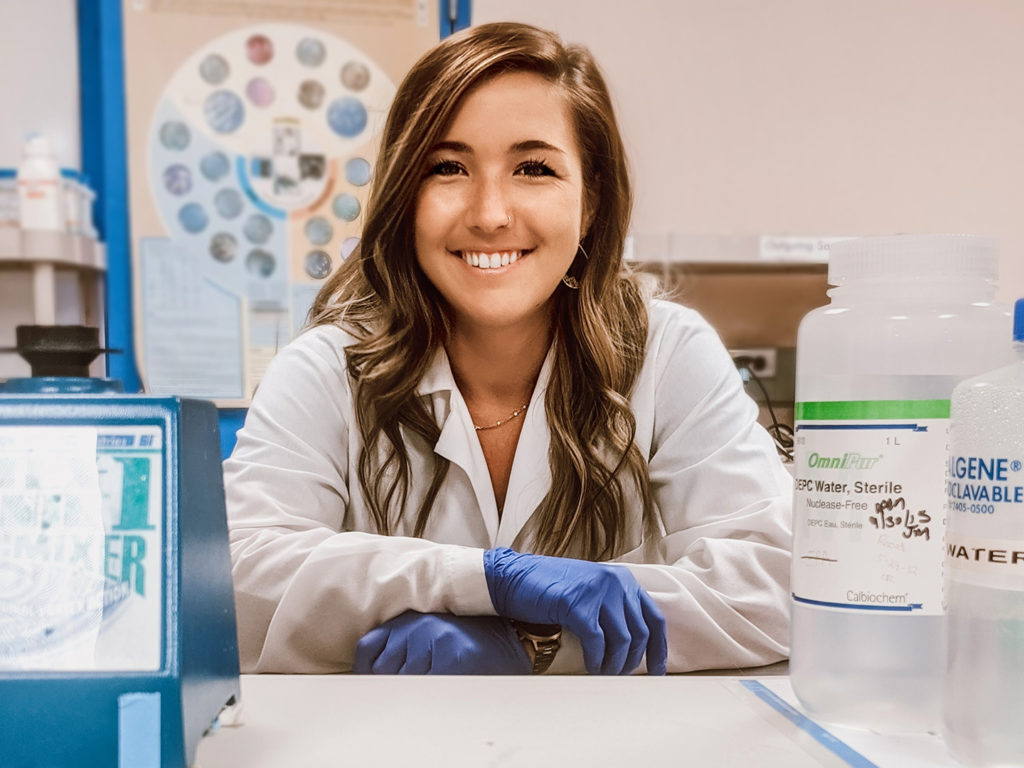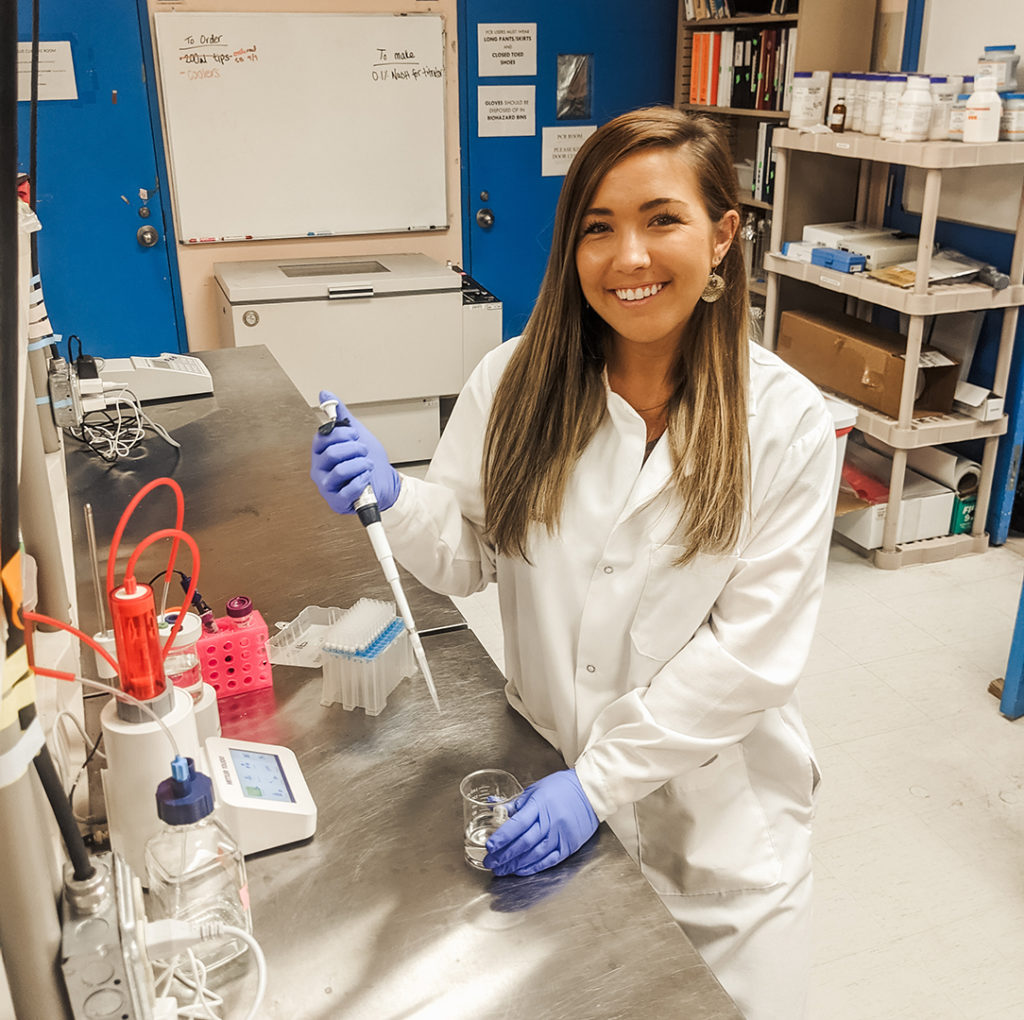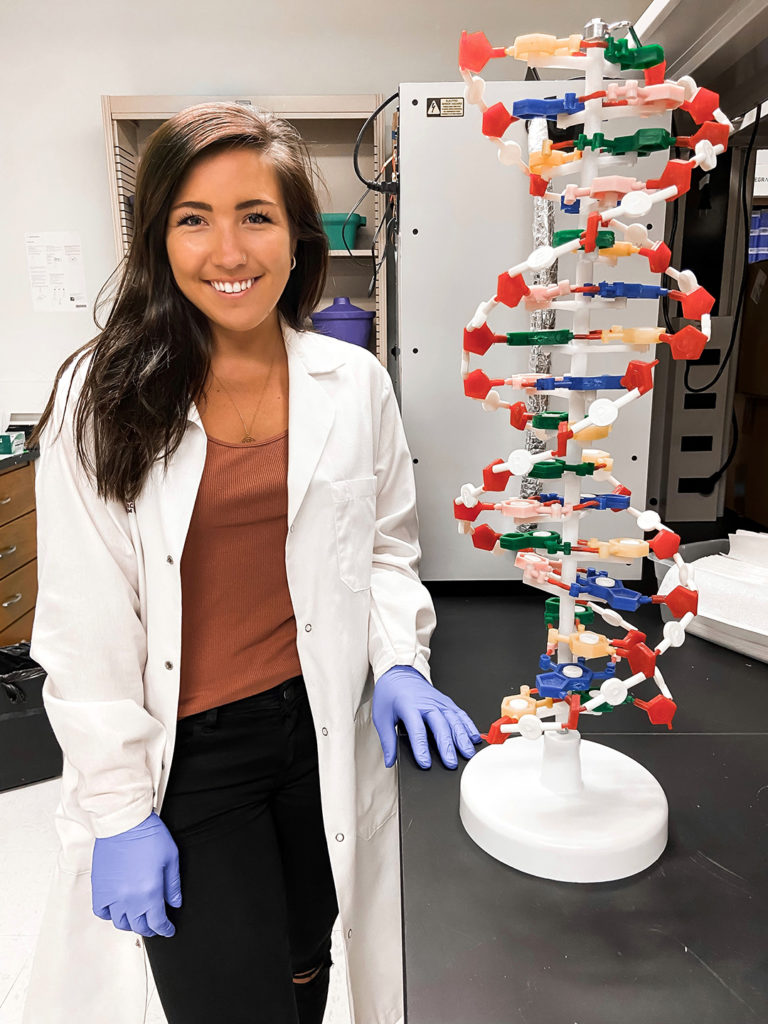Texas A&M Graduate Student Combines Science, Style, Education In Lifestyle Blog
Story by Margaret Preigh, CVMBS Communications

Allie Folcik, a fourth-year Ph.D. student in the toxicology program at the Texas A&M College of Veterinary Medicine & Biomedical Sciences (CVMBS), has had an interest in science for as long as she can remember, recalling that she was “dead-set” on becoming an astronaut from an early age.
Although her interests have since skewed to the terrestrial with a passion for environmental science and sustainability, she hopes to foster a similar fascination toward the natural world in other young women through her blog The Pretty PhD.
For Folcik, this blog became a release from current events and her rigorous academic program when the pandemic swung into full force in the United States last year.
“When COVID hit, I was looking for a creative outlet because I was so heavily involved in all of my technical work for my Ph.D. I really wanted to start something that would give me a more artistic outlet,” Folcik said. “I play guitar and I used to create ceramic pottery, so there was always that artistic side of me.”
She began blogging on her site, The Pretty PhD, covering everything from modern-day coupon clipping to harmful algal blooms.
“I wanted to somehow bridge all of the science I do on a regular basis that’s such a big part of who I am and other things that I’m interested in, like fashion, beauty, and different lifestyle topics,” she said.
In light of the pandemic, she has also included content that explains aspects of the COVID-19 outbreak in an understandable and engaging way to the general public.
Including both lifestyle and scientific content was important to Folcik, who says that multifaced interests are what makes a person unique. Rather than being confined by a single identity, she says that women should be empowered to embrace whatever interests them.
“My blog is about showing women and girls that you can do whatever you want and there are no boundaries to what defines you,” she said. “I’m someone who loves a lot of different things. I’m an ice hockey player, I’m an artist, (and) I’m a scientist. You can do what you want and you can still have a social life; you can follow your passions and still be really smart.”

A Blooming Interest In Conservation
Smart is an understatement for Folcik, who has an undergraduate degree in biochemistry, with a minor in sustainability, from the Florida Institute of Technology. She is currently in her fourth year of her Ph.D. in toxicology, studying novel methods for mitigating harmful algal blooms in drinking water.
Harmful algal blooms occur when colonies of algae, a type of aquatic plant, grow out of control and dominate their ecosystem at the expense of other species. Depending on the type of algae, they can deplete the oxygen levels of a body of water, clog the gills of fish, contaminate drinking water, and more.
“When harmful algal blooms occur in a lake or a source of water, they produce toxins that can get into drinking water,” she said. “If they’re not treated effectively, they can lead to public health issues down the road. We’re using a technology called electron beam to hopefully show that we can break down both the toxins and inactivate the cyanobacteria that are responsible for producing them.”
In addition to her academic pursuits, Folcik has also worked part-time with an environmental consulting firm for the past three years. She began the position as an intern but remained onboard to continue assisting with remediation and hazardous waste management through a one health approach that benefits both humans and the environment.
“I’m interested in natural disaster cleanup, especially. Taking the environmental consulting route and working on a case-by-case basis would be really interesting to me,” she said. “There are people in these companies who are needed to explain what we do from the risk assessment side and the science side to both the public and the client. I think doing the blog has really helped me see that that’s the area I want to really focus on instead of just the technical work.”
Teaching And Inspiring
Folcik has also extended her outreach efforts to the real world, meeting with high school students and giving presentations on women in STEM. These efforts have ranged from speaking with high school students in Chicago to a remote presentation in Dubai. She says she hopes to expose students to the world of academia in a more accessible way.
“I wish I had this exposure when I was in middle school or in high school to know that there are people who don’t get just funneled into academia and you never see them again,” she said. “I want to empower younger women to know that they have a place in STEM and that they have the full ability to get to wherever they want to be in their career.”
Her presentations and blog posts cover scientific topics in contexts that show how science is applicable to everyday life and products. Folcik hopes that this will not only make science more attractive to her audience but will also underscore its utility.
“For instance, when I got my hair dyed, I wrote a blog article about how hair dye works, how it changes, or how it stays in your hair and how the shaft opens,” she said. “If people can see that there are interesting ways to think about science, I hope that they see that it’s not something that’s scary.”

Addressing Pandemic Confusion
In light of the COVID-19 pandemic, she has also taken on the role of educator in both her personal circles and on her blog. Folcik says that much of the communication she has seen regarding COVID-19 is not written in a way accessible to the general reader.
“I did a lot of COVID articles explaining topics such as viruses vs. bacteria and mask wearing,” she said. “If anything, the whole pandemic just highlights how poor our science communication is because I’ve talked to plenty of friends and family who are not in the sciences who just feel so lost and so confused with what’s being put out and why things are being put out. I’m in a position where I’m able to translate that information into something other people can hopefully understand.”
Folcik is motivated by the attention her presentations and blogs have received and is hopeful that her work is making an impact. In addition to posting regularly on her blog, Folcik’s Instagram account has over 3,000 followers that engage regularly through series like “ToxTalksTuesday”.
“It’s awesome. I’m so glad that it’s growing because it validates that other people see value in both what I’m sharing and how I feel, because it is something I’m passionate about,” she said.
Embracing Many Passions
When asked what advice she wished she had received when she was younger, Folcik had two messages.
“The first would be that I was always afraid to try too many different things because as an 18-year-old undergrad, you feel you have to pick a major and map out your life,” she said. “I just wish someone had told me, ‘Do as many things as you want until you find the thing you like because that’s the only way that you’re going to be happy in your career.’
“The second piece of advice I wish I had gotten is that, especially going through my Ph.D. from a mental health standpoint, I think we need to be so much more open to conversation and to working on ourselves as we go through our schooling and careers. It’s OK to seek out help and it’s OK to spend time not only working on your academic profile, but also on your personal well-being.”
This insight is consistent with Folcik’s larger philosophy that people are mosaics of many interweaving interests and experiences; when we embrace the traits that make us unique, even if they don’t, at first, seem to overlap, we are better equipped to enrich the world around us.
“In the end, you’re a human being and you have your productivity and what your output is, but you also have an emotional side of you,” she said. “Focusing on all the different aspects of you is so important in your life development.”
###
For more information about the Texas A&M College of Veterinary Medicine & Biomedical Sciences, please visit our website at vetmed.tamu.edu or join us on Facebook, Instagram, and Twitter.
Contact Information: Jennifer Gauntt, Director of CVMBS Communications, Texas A&M College of Veterinary Medicine & Biomedical Sciences; jgauntt@cvm.tamu.edu; 979-862-4216


